
The American rider, trainer and author, Jane Savoie, has died at the age of 71 after a long battle with melanoma cancer. Jane began her riding career as an eventer but found her calling as a dressage rider in 1976. She commenced her dressage career on a broken-down racehorse with a bowed tendon, that had been abandoned in Linda Zang’s barn.
“He cost me a whopping $500, my life savings at the time,” Jane said. “It took me a year and a half to be able to canter this horse without him running away with me. I was so broke; my training consisted of only 2 things: The book, Complete Training of Horse and Rider by Alois Podhajsky, and one clinic a year with Cindy Sydnor. That’s two lessons a year.”
Jane Savoie had her greatest successes with the Dutch gedling, Zapatero (Nimmerdor / Watteau xx) and the pair were nominated as the reserve team horse for the bronze medal winning US Dressage team at the Barcelona Games in 1992.
Over the years, Jane competed many horses, but the one who brought her international acclaim was the bay gelding Zapatero.
She was also long listed by the USET on Genaldon and Jolicoeur. She briefly trained with Herbert Rehbein in Germany and competed in Canada, Holland, Belgium, France and Germany. She has won 9 Horse of the Year Awards and 3 National Freestyle Championships.
Jane Savoie developed an interest in Baroque horses after seeing a demonstration by Sabine Schut-Kery on Proud Meadow Friesians at Equitana Kentucky more than two decades ago.
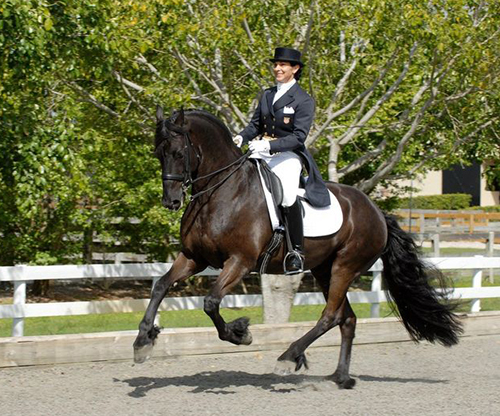
Jane’s own Grand Prix Friesian gelding Menno (aka Moshi) became highly popular on the American dressage scene with his own blog, writing to his readers to share his view on life as a dressage horse with Jane. She competed him on the Florida show circuit in the 2000s.
Savoie published six equitation books, four videos, and collaborated on eight additional titles.
She penned her first in 1992 titled “That Winning Feeling” and “Dressage 101”, “Dressage Between the Jumps”, “It’s Not Just About the Ribbons: It’s About Enriching Riding (and Life) with a Winning Attitude” followed.
She also produced a series of training DVD’s “Riding Mind’s Eye”, “Freedom from Fear”, “Learning the Half Halt”, “Program Your Position”, and many more.
On 30 December 2020, Savoie published her first dressage inspired fiction novel “Second Chances.”
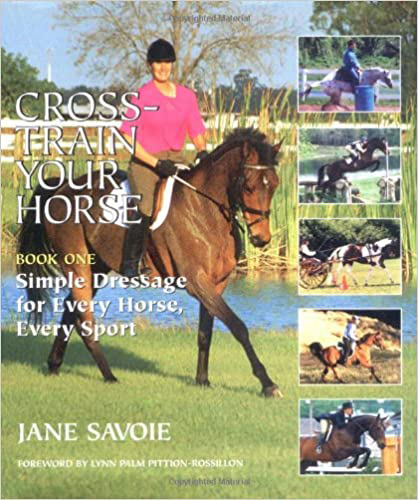
This extract is from the first book, Cross-Train Your Horse, and explains how to ‘lengthen’ your horse.
The Aids for Lengthenings
When you’re ready to ask for an upward transition to a lengthening, the aids applied simultaneously, as follows:
Seat: use a driving seat, as though you’re pushing the back of the saddle toward the front of the saddle.
Legs: press lightly with both legs to signal your horse to express his energy forward over the ground in longer strides.
Reins: soften your hands a bit forward, but keep a contact with your horse’s mouth, and a bend in your elbows. Do not ‘throw the reins away’.
Helpful Hints for Lengthenings
Here’s an image that will help you understand the type of suppleness you’re developing when you practice lengthenings. Think of your horse’s body as a rubber band that can easily stretch and contract. Not only will this quality make him more athletic, but it’s also extremely useful for all disciplines of riding. Take showjumping, for instance. Just think how many jumping faults could be avoided if your horse’s stride were easily adjustable like this!
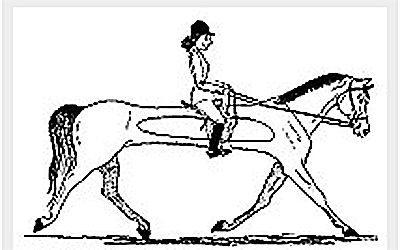
To help you understand the type of suppleness you need when doing lengthenings, think of your horse’s body as a rubber band that can easily stretch and contract…
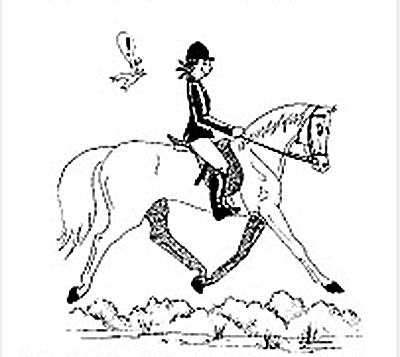
When asking for a lengthening, I picture my horse floating with his feet never touching the ground…
MAINTAINING THE TEMPO OF THE WORKING TROT
As with most new work, when you begin to incorporate lengthenings into your training, you start in the trot. It’s a bonus if you have a horse that can naturally lengthen his trot. Many Warmbloods and Arabians have this ability, but I’ve worked with a lot of Thoroughbreds, Connemaras, Morgans, and Quarter Horses who really need help developing their lengthenings in the trot.
If you ask your horse to lengthen in the way I’ve described, and the tempo gets quicker because he runs with short, fast steps, you need to systematically develop his lengthenings. Part of his difficulty may be purely physical. He may lack the suppleness and strength that he will gain in time by basic dressage training. But part of the problem may be that the horse just doesn’t understand that he is to take longer strides in the same tempo. He actually thinks he’s being obedient when he rushes off because he feels you close your legs, and he responds eagerly by immediately going forward.
I often find that I can help him understand that he is to lengthen his strides without speeding up, by asking for the lengthenings while going up hills. Once he gets the idea, I go back into the ring and see if he can transfer this concept of lengthening in the same tempo on the level footing.
Sometimes I do something unusual with the horse that tends to quicken his trot tempo when asked to lengthen. Since it takes time to develop the lengthening, I go out in a big field, or I go all the way around the ring and round off the corners so that I don’t have to slow down for them. First, I take up a heavier contact than normal. In this way, I can temporarily act as the horse’s fifth leg and purposely support him so he doesn’t lose his balance. Then I ask for a lengthening in posting trot. While posting to the trot, I rise very high and stay in the air a fraction of a second longer than normal. I pretend that I can hold the horse in the air with my body. And, in my mind’s eye, I picture him floating over the ground with his feet never touching the ground.
I ask my horse to give me a greater and greater effort and eventually one of two things will happen. The first is that he realizes that his legs can’t go any faster, and he ‘shifts into overdrive’ and takes some longer, slower steps. At this point, I immediately stop, praise him, and let him walk on a loose rein.
In my experience I’ve found that the first time, I might have to go all the way around a ring once or twice before I get a couple of longer, slower steps. But after the reward, the next effort yields results much sooner. And the same for the next attempt.
The other thing that might happen is that he loses his balance and falls into the canter. This isn’t the disaster it seems to be. If my horse hadn’t lost his balance and cantered, his next trot step probably would have been a bit longer. So I re-establish and immediately ask for a lengthening. It’s in that moment that I’m most apt to get a longer stride in a better tempo. And once again, if I get even one or two better steps, I stop and praise him. The reward helps the horse to understand that by doing something different, even if initially he doesn’t understand what it is, he’ll be praised.
Once I get two or three better steps as soon as I ask for the lengthening, I leave them for another day. During each session the horse builds his understanding of what’s being asked, and over time he physically gets strong enough to lengthen in a good tempo for a greater number of steps.
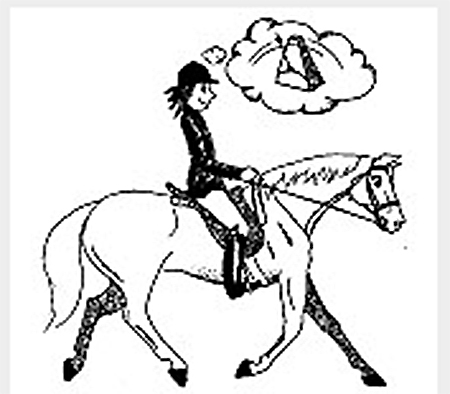
Pretend you hear a metronome ticking. The tempo of the extended trot should not change at all from the ‘ticking’ you heard in his working trot…
HEAR THE TEMPO
Use some good auditory images to help you while you’re teaching your horse to lengthen in the same tempo as his working gait. Pretend you’re standing by a paved road and your eyes are closed. Because the tempo stays exactly the same, you can’t tell from the sound of the footfalls whether your horse is in the working gait, lengthening, or doing the transition in between. Here’s another auditory image to help you teach your horse to lengthen the trot in the same tempo as his working trot. Pretend you hear a metronome ticking. The tempo stays exactly the same both when you’re in working trot and when you’re in the lengthening. Even though I’m discussing trot lengthenings at the moment, you can use the same type of auditory image if your horse quickens his tempo in a canter lengthening. ‘Hear’ the tempo as if your horse is moving over the ground with big, ground-covering bounds in slow motion.
If your horse still tends to quicken his tempo when you ask him to lengthen, overcompensate by imagining that you ‘hear’ the tempo get slower. Pretend that the tempo gets slower because your horse stays suspended in the air for a long time. If you’re doing a posting trot, try rising and sitting more slowly to see if you can be the one to set the pace rather than automatically posting at the speed that your horse chooses.
USE FIRMER CONTACT FOR SUPPORT
Don’t be surprised if the contact with your horse’s mouth during lengthening becomes somewhat heavy. Remember that lengthenings are developed out of a working gait and the weight in your hands is somewhat firm to begin with. In addition, while your horse is learning how to balance himself during lengthenings, his centre of gravity might shift even a bit further to his forehand. Don’t be alarmed by this. It’s a stage of his training, and it’s fine to temporarily support him by maintaining a firmer contact. Later on, if you decide to go on to more advanced work, you’ll develop ‘uphill’ extensions out of collected gaits. Because the horse will be in self-carriage when he’s in a collected gait, the contact will be lighter.
However, there’s a difference between a supporting contact, and one in which your horse is leaning so heavily on your hands that your arms ache. Here are some things you can try to improve a contact that is too heavy. Before you even begin to ask for a lengthening, make sure you drive the horse’s hind legs more under his body by closing both of your legs. In order to carry himself, your horse needs to have his hind legs underneath him. If his hind legs are trailing out behind his body, he can’t support himself in the lengthening and so leans on your hands..
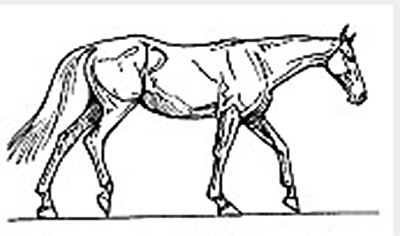
A horse trotting with his legs trailing out behind his body…
You can also ride transitions: from trot to halt and back to trot again, or from the canter to the walk and back to the canter again. This will help to rebalance the horse.
Another reason the contact can get too heavy is that you may be asking for too many lengthened strides at one time before your horse is ready. Doing well-balanced lengthening with his hind legs underneath his body for only a few strides at a time is much more valuable for your horse than lengthening for many strides with his hind legs pushing out behind his body. Remember that when you do the downward transition back to the working gait, be sure that you maintain leg contact to keep his hind legs under his body. It might feel natural to ask for the downward transition from the lengthening to the working gait by just using the reins. But, as you know by now, if your goal is to rebalance your horse and improve the contact, you need to add hind legs while doing the downward transitions.
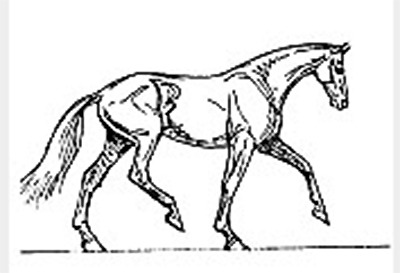
Horse trotting with his hind legs under him. The activity of the hind legs directly affects the horse’s balance…
ALLOW THE FRAME TO ELONGATE IN LENGTHENINGS
In trot lengthenings, the front feet should touch the ground on the spot toward which they are pointing when each leg is at its maximum extension. When a horse has to draw his front legs back toward his body before placing them on the ground, or his toes flip up in front, it usually indicates that he hasn’t been allowed to lengthen his frame.
Sometimes a rider makes it difficult for the horse to lengthen to his utmost. Although I said earlier that you shouldn’t be concerned in the contact is a bit too firm, you want to be sure that you’re not making it heavy because you’re cranking his neck in. If you keep your horse’s neck short by restricting him with strong or non-allowing hands, he has to draw his foreleg back before putting it down. Allow your horse to lengthen his neck and point the tip of his nose more or less forward. To help you to do this, think about ‘opening the front door’ by softening your hands a bit toward your horse’s mouth and by cocking your wrists upward in a way that allows your little fingers to go more forward.
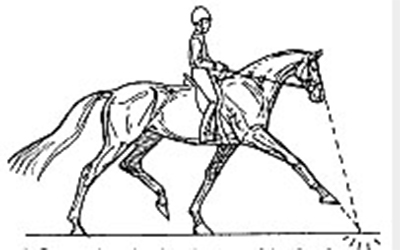
a) Correct lengthening – the toe of the forefoot points toward the spot where it will touch down. The foreleg cannot touch down in front of an imaginary line from an extension of his profile to the ground…
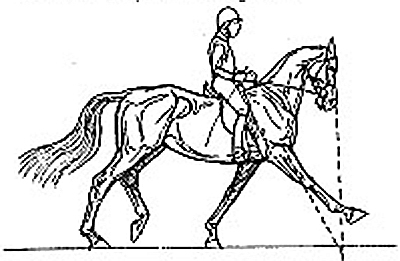
b) Incorrect lengthening – the horse’s toe flips up; his back is tense and his front foot has no option but to retract before he can place it on the ground. The position of the head and neck affects the quality of the lengthening…
SIT UPRIGHT
When you use your driving seat to ask for the transition into the lengthening, don’t try to ‘help’ your horse to lengthen by leaning back. Even though you might feel that you can drive him forward this way (and I see many dressage riders doing this in lengthenings and extensions) you’ll just end up driving his back down and making it hollow. Stay vertical at all times.
I learned this lesson the hard way while trying to qualify for the Olympic Festival with Jolicoeur at a competition that was being held at Knoll Farm in Brentwood, New York, back in 1987. One of the finest international judges in the world, the late Mr Jaap Pot, was there. He was a stickler when it came to the correctness of the rider’s seat. I remember Jo and I doing huge extended trots for him. I thought we had done really well until my score sheet came back with extremely low marks for the extensions and the simple comment – ‘Rider leaning behind the vertical’. Believe me, it made an impression!


